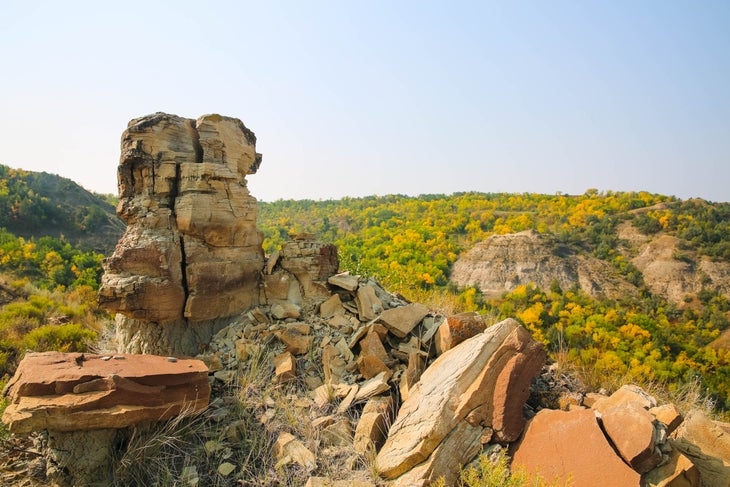Heading out the door? Read this article on the new Outside+ app available now on iOS devices for members! Download the app.
Last September, the Mandan, Hidatsa, and Arikara Nation held a soft opening of the Three Affiliated Tribes National Park in North Dakota. The newly-acquired, 2,100-acre former ranch was once a part of the tribes’ original treaty lands, only to later be lost when the federal government reduced the size of their reservation. But when the land’s owners posted it for sale, the tribes saw it as an opportunity to not only reclaim their history but also share it with others.
The park is located just south of the Missouri River next to the Fort Berthold Reservation. While Badlands National Park sits in the southwestern part of South Dakota, this North Dakota region shares a lot of the Badlands geological and environmental characteristics, leading many people to refer to it as the “rugged Badlands.”
Superintendent Ethan White Calfe told Backpacker that the park is “very dynamic.”
“Weather changes very abruptly here,” he said. “It’s a land of extremes. … And though the park seems to be this really desolate place, it’s not. It’s a thriving ecosystem and there are a lot of things that call that place its home in terms of flora and fauna. It seems like a harsh landscape but it’s also fragile at the same time.” Besides its
White Calfe said, “[The park] has a lot of very important cultural significance to our people.” And that it protects a number of different sites.
Besides its natural heritage, White Calfe notes that the new park “has a lot of very important cultural significance” for the Three Affiliated Tribes. Archaeologists have found that various Native peoples have been living in the Badlands region for at least 12,000 years. Acquiring the land offered the tribes a way to adhere to their mission statement: “Reconnecting with place for the betterment of our communities by the reinforcement of our tribal identity and providing opportunities to share with the outside world our connection and conceptualization of landscape.”

At the moment, the Three Affiliated Tribes National Park is only open to foot traffic. Those who visit the park must acquire a free permit online, and park administrators encourage them to limit travel to established trails due to the park’s fragile ecosystems.
“Currently, we’re just making trails” explained Mary Fredericks, director of MHA Parks and Reserves. At the moment, there are about 10 miles of trails in the park, but park officials have been plotting different ways to turn the area into a recreational haven.
“We’ve started a collaboration with the Maah Daah Hey Trail,” said Fredericks, referring to the 144-mile non-motorized trail that travels through both the Badlands and Theodore Roosevelt National Park. The end goal is to create a large trail network and access to waterways.
Additionally, park employees will be working to restore native prairies while removing invasive species. Officials are also working to establish a visitor’s center and a campground. There is a rustic campground on the northern side of the river managed by the U.S. Army Corps of Engineers that visitors can use while the Three Affiliated Tribes National Park continues to develop its own sites.
When asked why the tribes decided to open their land to visitors, Fredericks stated, “We have always been a people who have welcomed others in. When Lewis and Clark came in, we welcomed them into our camps.”
“The purpose and intention [revolves around] conservation, recreation and education,” Fredericks said. “That’s definitely something that our tribal leaders took into consideration when they designated this as building a bridge and being a welcoming space.”
Looking forward, officials hope to make the park a four-season destination by opening its doors to snowshoers and cross country skiers. For now, though, the park will kick off the season with its spring hike series on May 31.
From 2025
